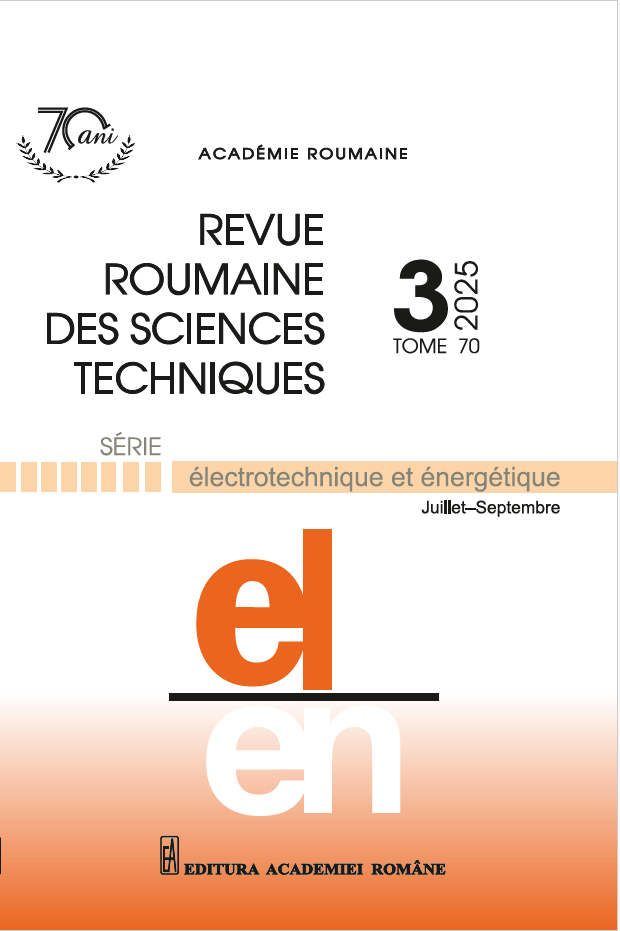HYPOTHÈSE UTILE POUR L'ANALYSE NUMÉRIQUE SIMPLIFIÉE DE LA STIMULATION MAGNÉTIQUE TRANSCRÂNIENNE
DOI :
https://doi.org/10.59277/RRST-EE.2025.3.24Mots-clés :
Stimulation magnétique transcrânienne (TMS), Courant inducteur, Analyse numérique, Méthode des éléments finis (MEF)Résumé
La stimulation magnétique est un effet bioélectromagnétique consistant à exposer le corps humain à un champ magnétique variable dans le temps ; les tissus excitables (nerfs, muscles, organes sensoriels) peuvent être activés par le champ électrique (ou le courant électrique associé) généré par induction électromagnétique. Les effets biologiques de la stimulation ont des applications médicales dans une classe dynamique de techniques de neuromodulation, comme la stimulation magnétique transcrânienne. Cependant, une exposition humaine dangereuse à des champs magnétiques de basse fréquence et de forte amplitude peut également être associée à une incidence accrue de risques pour la santé, comme observé dans des scénarios d'exposition professionnelle spécifiques. Cette étude présente quelques problèmes typiques liés à la simulation numérique des problèmes de champs électromagnétiques de cette classe (formulation, données, méthodes, mise en œuvre, précision), fournit des estimations quantitatives spécifiques (post-traitement des solutions électromagnétiques) et illustre la possibilité pratique de réduire la consommation de ressources de calcul en adoptant une description simplifiée du problème qui remplace l'analyse transitoire par une analyse harmonique temporelle.
Références
(1) S. Ueno, M. Sekino, Biomagnetics. Principles and Applications of Biomagnetic Stimulation and Imaging (Chapters 2 and 3 on Biomagnetic Stimulation), CRC Press, Taylor&Francis Group (2016).
(2) P.M. Rossini et al., Non-invasive electrical and magnetic stimulation of the brain, spinal cord, roots and peripheral nerves: Basic principles and procedures for routine clinical and research application, Report from an IFCN Committee, Clinical Neurophysiology, 89, 6, (2015).
(3) A.M. Morega, M. Morega, A.A. Dobre, Computational Modeling in Biomedical Engineering and Medical Physics (Chapter 7 - Magnetic stimulation therapy), Academic Press, Elsevier Inc., pp. 217-245 (2021).
(4) C.M. Ciocăzanu, N.S. Stanciu, M. Morega, An Electrical Engineering Perspective on Neuromodulation – Characteristics of the Magnetic Stimulation Procedure, U.P.B. Sci. Bull., Series C, 86, 4, pp. 349–366 (2024).
(5) A.T. Barker, R. Jalinous, I.L. Freeston, Non-Invasive Magnetic Stimulation of Human Motor Cortex, The Lancet. 325, 8437, pp. 1106–1107 (1985).
(6) C. Hovey, R. Jalinous, The Guide to Magnetic Stimulation, © The Magstim Company Ltd. (2006).
(7) ***Magstim® Inc., Pioneers in Neurotechnology. MAGSTIM TMS Catalog The Magstim® Company Ltd. (2024).
(8) Z.D. Deng, S.H. Lisanby, A.V. Peterchev, Electric field depth-focality tradeoff in transcranial magnetic stimulation: Simulation comparison of 50 coil designs, Brain Stimul. 6, pp. 1–13 (2013).
(9) V. Guadagnin, M. Parazzini, S. Fiocchi, I. Liorni, P. Ravazzani, Deep Transcranial Magnetic Stimulation: Modeling of Different Coil Configurations, IEEE Trans. Biomed. Eng., 63, 7, pp. 1543–1550 (2016).
(10) M.I. Gutierrez, et al., Devices and Technology in Transcranial Magnetic Stimulation: A Systematic Review, Brain Sci., 12, 9, art. no. 1218 (2022).
(11) T. Kowalski, J. Silny, H. Buchner, Current density threshold for the stimulation of neurons in the motor cortex area, Bioelectromagnetics 23, 6, pp. 421–428 (2002).
(12) A. Barchanski, Simulations of Low-Frequency Electromagnetic Fields in the Human Body, PhD Thesis, TU Darmstadt (2007).
(13) S. Ueno, New Horizons in Electromagnetics in Medicine and Biology, Radio Science, 56, 4, 17 pages (2021).
(14) D. Rafiroiu, S. Vlad, L. Cret, R. Ciupa, 3D Modeling of the Induced Electric Field of Transcranial Magnetic Stimulation, IFMBE Proc., 26, pp. 333–338 (2009).
(15) N.J. Tachas, K.G. Efthimiadis, T. Samaras, The Effect of Coil Modeling on the Predicted Induced Electric Field Distribution During TMS, IEEE Transactions on Magnetics, 49, 3, pp. 1096–1100 (2013).
(16) ***IEEE Std C95.1-2019 for Safety Levels with Respect to Human Exposure to Electric, Magnetic, and Electromagnetic Fields, 0 Hz to 300 GHz, Annex B.2 Rationale for limits based on electrostimulation, Copyright © 2019 IEEE.
(17) M. Lu, S. Ueno, Computational Study Toward Deep Transcranial Magnetic Stimulation Using Coaxial Circular Coils, IEEE Transactions on Biomedical Engineering, 62, 12, pp. 2911–2919 (2015).
(18) E. Salkim, T. Abut, Human Head Transcranial Magnetic Stimulation using Finite Element Method, Kocaeli Journal of Science and Engineering, 7, 1, pp. 62–70 (2024).
(19) A. Ramaiah, P.D. Balasubramanian, A. Appathurai, M. Narayanaperumal, Detection of Parkinson’s disease via Clifford gradient-based recurrent neural network using multi-dimensional data, Rev. Roum. Sci. Tech. – Électrotechn. et Énerg., 69, 1, pp.103–108 (2024).
(20) L.E. Dorobanţu, Biomedical Signal Processing in Cognitive Research: Brain Fingerprinting and Polygraph Testing, Rev. Roum. Sci. Techn.–Électrotechn. et Énerg., 70, 2, pp. 263–268 (2025).
Téléchargements
Publiée
Numéro
Rubrique
Licence
(c) Copyright REVUE ROUMAINE DES SCIENCES TECHNIQUES — SÉRIE ÉLECTROTECHNIQUE ET ÉNERGÉTIQUE 2025

Ce travail est disponible sous licence Creative Commons Attribution - Pas d'Utilisation Commerciale - Pas de Modification 4.0 International.


